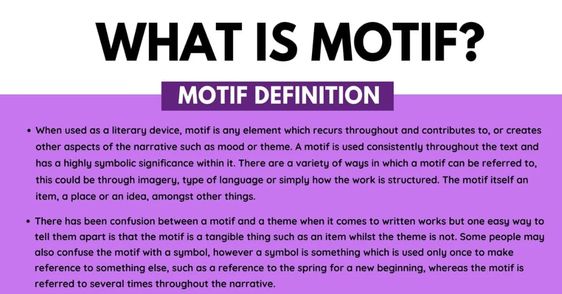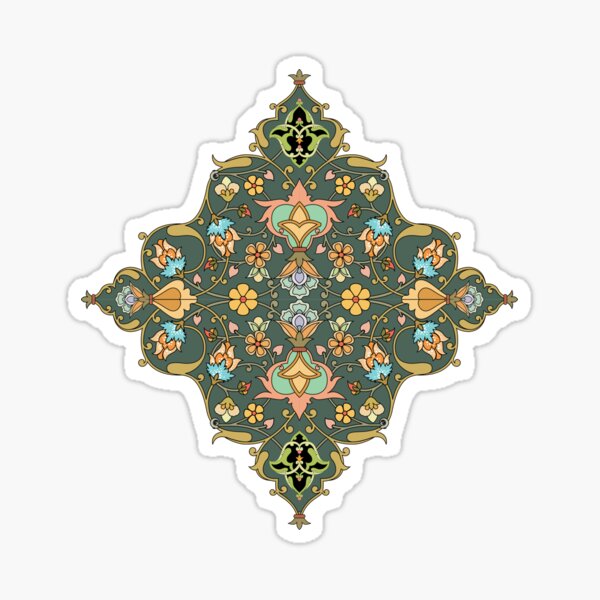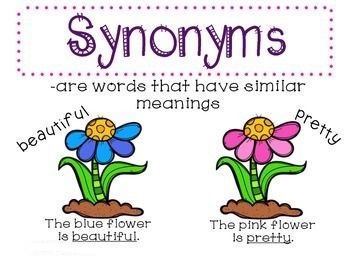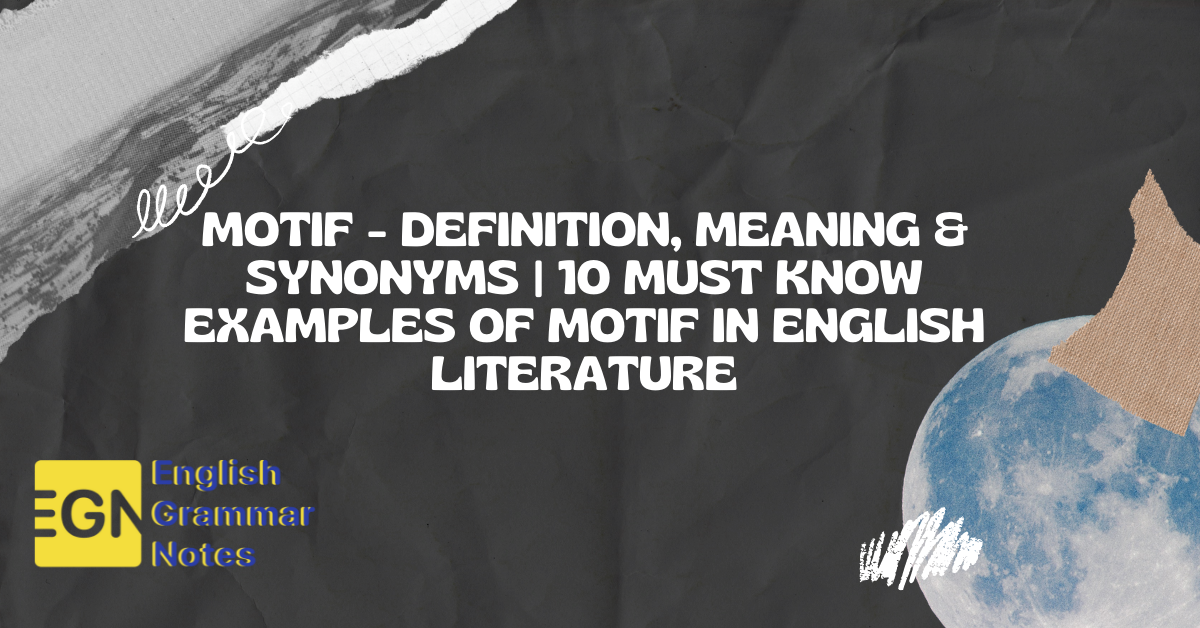Motifs are literary devices that play a significant role in the development of major themes in a literary work and help readers to find out the underlying messages that you want to communicate. The term motif has its roots in the French phrase motif meaning “pattern.” In this article, you will be introduced to all the essential information about motifs including their definition, literary examples, significance, etc.
- What is a Motif?
- Motif Examples
- Significance of Using Motifs
- Motif Vs Symbols
- Motif Vs Theme
- Motif Synonyms
- What is a Motif?
- Distinguish between a motif and a symbol?
- What are some of the synonyms of motifs?
- Distinguish between theme and motif?
What is a Motif?
A motif, pronounced moh-teef, refers to an image or idea that is frequently used in a literary work. Motifs can be ideas, symbols, sounds, actions, or words. The use of this literary device strengthens your story through the addition of images and ideas to the themes presented.
Motif Examples
In literature, motifs are employed to bring forth an important theme. Given below are some examples:
- Heart of Darkness by Joseph Conrad- Motifs occur in the form of eavesdropping and overhearing.
- Old Man and the Sea by Earnest Hemmingway: To describe Santiago’s wounds, the author speaks of the types of wounds Jesus
- Christ experienced. Here he likens Santiago to a Christ like figure.
- Pride and Prejudice – Jane Austen: Uses the motif of travel to highlight the theme of change and growth.
Significance of Using Motifs
The use of motifs is beneficial in several ways:
- Motifs help to emphasize the main ideas or themes
- Evokes a mood
- Creates symbolic meaning
- Motifs attribute a traceable pattern to a text.
- Motifs help you to create a more poetic and structured narrative.
English Grammar Notes present on our website cover popular grammar points using simple explanations, and examples with answers and makes your practice easier.
Motif Vs Symbols
Symbols are images or objects that stand for a larger idea or theme. The difference between a symbol and a motif is: Motifs are symbols that are repeatedly used throughout a work. On the other hand, a symbol can stand alone so that it may be used only in a single scene. Hence symbols can be considered as a subset of motifs.
Motif Vs Theme
Just like symbols fall under motifs, motifs come under the category of themes. Themes refer to the central ideas or concepts introduced in a story. Motifs are used to emphasize such themes using images and symbols throughout the story. A motif can be considered as a clue to reach the themes in a work.
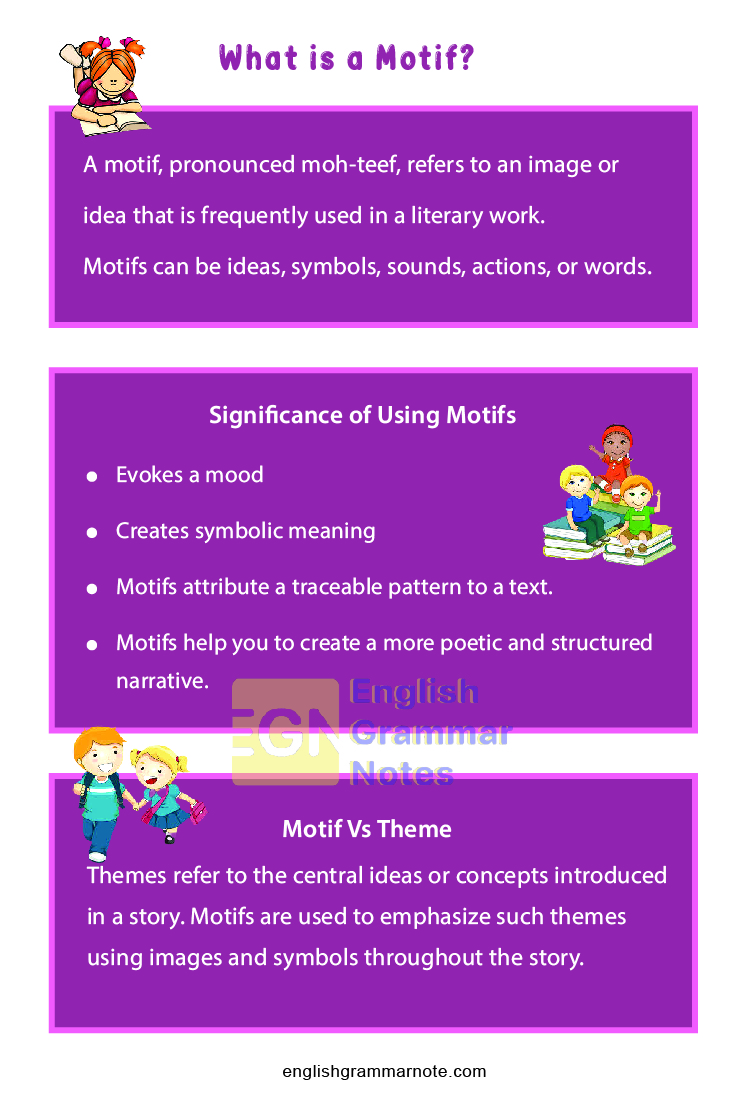
Motif Synonyms
Some words have distant meanings in a general sense, therefore its synonyms include figure, shape, pattern, design, decoration, device, ornament, emblem, or even logo.
See More:
FAQs on Motif
A motif, pronounced moh-teef, refers to an image or idea that is frequently used in a literary work. Motifs can be ideas, symbols, sounds, actions, or words.
2. Distinguish between a motif and a symbol?
The difference between a symbol and a motif is: Motifs are symbols that are repeatedly used throughout a work. On the other hand a symbol can stand alone so that it may be used only in a single scene.
3. What are some of the synonyms of motifs?
Some synonyms of the term motif include figure, shape, pattern, design, decoration, device, ornament, etc.
4. Distinguish between theme and motif?
Themes are the central ideas or concepts introduced in a story. Motifs on the other hand are devices used to emphasize such themes using images and symbols throughout the story.
Conclusion
Motif is one of the most useful literary devices when it comes to writing. Motifs are devices that can be found in any creative work including stories, songs, poems, television shows, advertisements, and films. The use of motifs will surely attract readers and will help you to emphasize important ideas or concepts. Motifs are easily recognizable to you once you understand their definition and their usage in literature.
